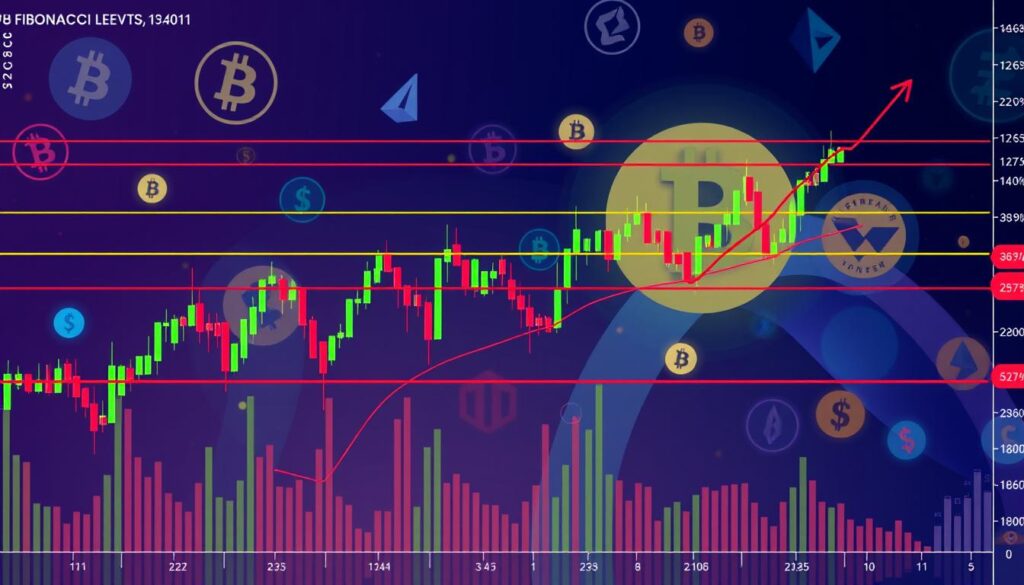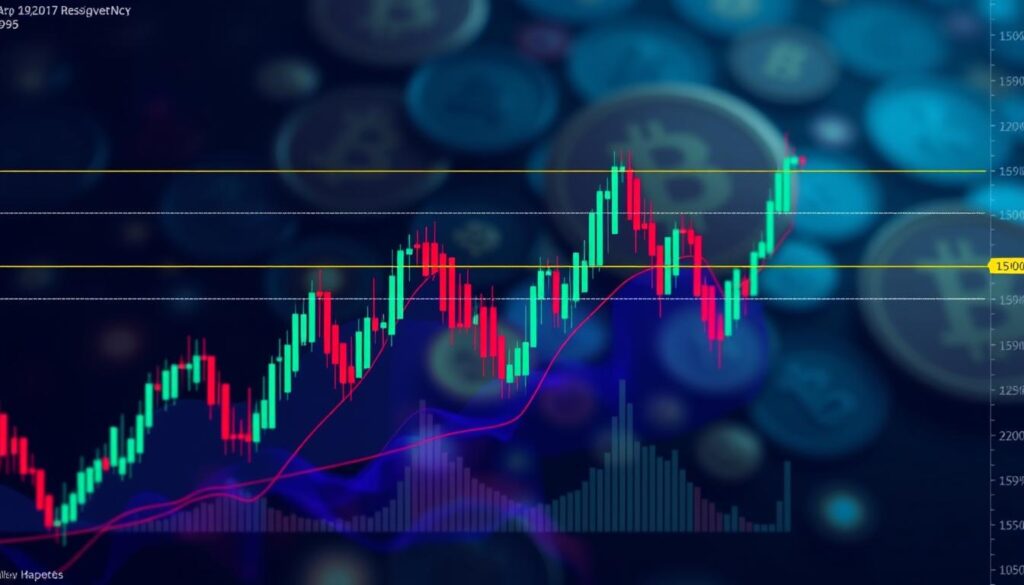Fibonacci retracement is a popular technical analysis tool used to identify potential areas of support and resistance in price movements. This mathematical tool, rooted in nature’s patterns, has found its way into financial markets, including crypto trading. By mastering Fibonacci retracement, traders can gain valuable insights into market trends and potential reversals, ultimately making more informed decisions in their crypto trading endeavors.
The Fibonacci sequence, discovered by Italian mathematician Leonardo Pisano Bogolla, is used to calculate Fibonacci retracement ratios in crypto trading. These ratios help traders identify key support and resistance levels, which can be used to validate trades and anticipate potential trend continuation or reversal points. Fibonacci retracement levels are static markers that do not fluctuate like moving averages, making them a reliable tool for traders to anticipate and identify support and resistance price points during crypto trading.
Table of Contents
Key Takeaways
- Fibonacci retracement is a technical analysis tool used to identify potential areas of support and resistance in price movements.
- The Fibonacci sequence is used to calculate Fibonacci retracement ratios in crypto trading.
- Fibonacci retracement levels can be used to validate trades and anticipate potential trend continuation or reversal points.
- Fibonacci retracement is a popular tool among traders due to its self-fulfilling predictions and ability to offer insights into market trends and potential reversals.
- Utilizing Fibonacci retracement ratios along with other technical indicators can help traders make more informed decisions in their crypto trading endeavors.
- Fibonacci retracement can be used on both short and long trading intervals, providing insights into market entries and exits.
Understanding the Fibonacci Sequence in Trading
The Fibonacci sequence is a series of numbers in which each number is the sum of the two preceding numbers, starting from 0 and 1. This sequence has been observed in various aspects of nature and has been applied to financial markets to identify potential price reversals. The golden ratio, approximately equal to 1.618, is derived from the Fibonacci sequence and plays a crucial role in understanding market patterns.
The application of the Fibonacci sequence in trading is based on the idea that prices tend to reverse at levels that are related to the golden ratio. These levels, known as Fibonacci retracement levels, are calculated as percentages of a price move. For example, the 23.6%, 38.2%, and 61.8% levels are commonly used in trading. Fibonacci retracement levels can be used to identify potential support and resistance areas, aiding traders in making informed decisions.
The significance of the golden ratio in financial markets can be seen in the way prices tend to move in relation to these levels. By understanding the Fibonacci sequence and its application in trading, traders can gain insights into market patterns and make more informed decisions. The following are some key Fibonacci retracement levels:
- 23.6%
- 38.2%
- 61.8%
These levels are derived from the Fibonacci sequence and are used to identify potential reversal points in market trends. By applying the Fibonacci sequence to trading, traders can develop a structured approach to technical analysis and improve their trading decisions.
The Basics of Fibonacci Retracement Levels
Fibonacci retracement levels are a crucial tool in crypto trading, helping traders identify potential reversal points in price trends. These levels are derived from the Fibonacci sequence, a series of numbers in which each number is the sum of the two preceding numbers (0, 1, 1, 2, 3, 5, 8, 13, and so on). The Fibonacci retracement tool uses key ratios such as 0.382, 0.500, and 0.618 to determine these levels.
The most commonly used Fibonacci retracement levels are 23.6%, 38.2%, 50%, 61.8%, and 78.6%. These levels are used to identify potential areas where a price may reverse or stall, aiding in decision-making for entering and exiting positions. By applying Fibonacci retracement analysis to a crypto price chart, traders can visualize these levels and make more informed decisions. The price action of a cryptocurrency can be influenced by these levels, making them a valuable tool for traders.
Some key points to consider when using Fibonacci retracement levels include:
- Identifying potential support and resistance levels for price reversals
- Combining Fibonacci retracements with other technical tools for confirmation
- Using Fibonacci retracement levels to inform risk management decisions, such as setting stop losses and take profit targets
By understanding and applying Fibonacci retracement levels, traders can gain a deeper insight into the price action of cryptocurrencies and make more informed decisions. The retracement tool is a valuable resource for traders, helping them to identify potential reversal points and adjust their strategies accordingly.
Key Fibonacci Ratios for Crypto Trading
Fibonacci ratios are essential in crypto trading, providing traders with key levels to inform their trading strategy. The most crucial Fibonacci ratios used in crypto trading include 23.6%, 38.2%, 50%, 61.8%, and 100%. These ratios are derived from the Fibonacci sequence and are used to identify potential support and resistance levels.
The 0.618 level, also known as the “golden pocket,” is considered the most important Fibonacci retracement level. Traders use this level to identify potential reversal zones and to set stop-loss orders. Other key levels, such as 0.382 and 0.786, are also used to identify potential support and resistance levels.
The 0.618 Retracement Level
This level is found by dividing one number in the Fibonacci sequence by the number that follows it. The 0.618 retracement level is often used as a target price for trades, as it is believed to be a level where the price will reverse.
The 0.382 and 0.786 Levels
These levels are also derived from the Fibonacci sequence and are used to identify potential support and resistance levels. The 0.382 level is found by dividing a number in the sequence by the number located two spots to the right, while the 0.786 level is found by dividing a number in the sequence by the number located three spots to the right.
Extended Fibonacci Levels
Extended Fibonacci levels, such as 1.618, 2.618, and 4.236, are used to project potential price targets beyond the original trend. These levels are calculated using a string of numbers to identify potential support and resistance levels.
Setting Up Your Crypto Trading Platform for Fibonacci Analysis
To start using Fibonacci retracement tools, you need to set up your crypto trading platform. Many popular platforms, including KuCoin and TradingView, offer built-in Fibonacci retracement tools. These tools are designed to help you identify potential support and resistance levels in the market.
When setting up your trading platform, you’ll want to familiarize yourself with the Fibonacci tools available. This may include drawing tools, such as retracement lines and extensions, as well as indicators that can help you identify key levels. A proper chart setup is essential for effective Fibonacci analysis.
Here are some steps to follow when setting up your platform:
- Choose a platform that offers built-in Fibonacci retracement tools
- Familiarize yourself with the platform’s drawing tools and indicators
- Set up your chart with the correct time frame and instrument
- Draw retracement lines and extensions to identify key levels
By following these steps, you can set up your crypto trading platform for Fibonacci analysis and start identifying potential trading opportunities. Remember to always use your trading platform in conjunction with other forms of analysis, such as technical and fundamental analysis, to make informed trading decisions.
With the right chart setup and Fibonacci tools, you can take your trading to the next level. Start exploring your platform’s Fibonacci features today and discover the power of Fibonacci analysis in crypto trading.
| Platform | Fibonacci Tools | Chart Setup |
|---|---|---|
| KuCoin | Retracement lines, extensions | Customizable time frames and instruments |
| TradingView | Retracement lines, extensions, indicators | Advanced charting capabilities |
How to Draw Fibonacci Retracement Lines Correctly
To draw Fibonacci retracement lines, it’s essential to identify a completed trend and draw the tool from the swing low to the swing high (or vice versa for downtrends). This technique is crucial in trend analysis, as it helps traders identify potential areas of support and resistance. When drawing Fibonacci, traders should focus on key levels such as 38.2%, 50%, and 61.8%, which represent potential swing points where prices may reverse.
Some common Fibonacci levels used in trading include:
- 23.6%
- 38.2%
- 50%
- 61.8%
- 78.6%
These levels are derived from the golden ratio and can be used to identify potential areas of support and resistance in both uptrends and downtrends. By combining Fibonacci retracement with other technical tools, traders can gain a more comprehensive understanding of market trends and make more informed trading decisions.
When using Fibonacci retracement in crypto trading, it’s essential to remember that these levels should be seen as areas of interest rather than exact reversal points. Prices may move slightly beyond these levels before reversing, so traders should always use proper risk management techniques, including setting logical stop-loss levels and establishing take-profit targets in advance.
| Fibonacci Level | Percentage |
|---|---|
| 0.236 | 23.6% |
| 0.382 | 38.2% |
| 0.5 | 50% |
| 0.618 | 61.8% |
| 0.786 | 78.6% |
Implementing Fibonacci Retracement in Crypto Trading
To successfully implement Fibonacci retracement in your trading strategy, it’s essential to combine it with thorough market analysis and effective risk management. This approach will help you identify potential buy or sell signals and price targets in crypto markets. The most important Fibonacci levels used in crypto trading are 0.618, 0.786, and 1.000, with the golden ratio of 61.8% being the most critical level.
When using Fibonacci retracement, consider the following key points:
- Combine Fibonacci retracement with Simple Moving Averages (SMA) to increase the reliability of trade setups in a trending market.
- Utilize Fibonacci retracement in conjunction with the correct swing high/low points to have a meaningful impact on price movements.
- Long-term trend analysis can provide more significant insights when using Fibonacci levels in cryptocurrency trading.
A well-rounded trading strategy should incorporate Fibonacci retracement levels to identify hidden dynamic support and resistance levels not easily visible on charts. Common Fibonacci retracement levels used in crypto trading include 0.236, 0.382, 0.618, and 0.786. By incorporating these levels into your market analysis and risk management plan, you can make more informed trading decisions.
Remember to always prioritize risk management when using Fibonacci retracement in your trading strategy. This will help you minimize potential losses and maximize gains. By combining Fibonacci retracement with other technical indicators and fundamental analysis, you can develop a comprehensive trading approach that suits your needs.
| Fibonacci Level | Retracement Percentage |
|---|---|
| 0.236 | 23.6% |
| 0.382 | 38.2% |
| 0.618 | 61.8% |
| 0.786 | 78.6% |
Using Fibonacci for Entry Points
Fibonacci retracement levels can be used to identify potential entry points in both bull and bear markets. By analyzing these levels, traders can make informed decisions about when to enter a trade. In a bull market, traders often look to buy at Fibonacci retracement levels, as these levels can act as support zones. On the other hand, in a bear market, these levels can be used for short entries, as they can act as resistance zones.
The psychology of traders often leads to price reactions at Fibonacci retracement levels, making them a valuable tool for traders. By observing these patterns in real market conditions, traders can gain insights into potential entry points. While no strategy is foolproof, Fibonacci retracement can provide valuable insights for timing entries.
Bull Market Entry Strategies
In a bull market, traders can use Fibonacci retracement levels to identify potential entry points. For example, if a cryptocurrency is experiencing a rally, traders can look to buy at the 50% or 61.8% Fibonacci retracement level, as these levels can act as support zones. By combining Fibonacci retracement with other technical indicators, such as trend lines and moving averages, traders can increase their confidence in their trades.
Bear Market Entry Strategies
In a bear market, traders can use Fibonacci retracement levels to identify potential short entry points. For example, if a cryptocurrency is experiencing a downturn, traders can look to short at the 50% or 61.8% Fibonacci retracement level, as these levels can act as resistance zones. By analyzing these levels, traders can make informed decisions about when to enter a trade.
By using Fibonacci retracement levels to identify potential entry points, traders can gain an edge in the market. Whether in a bull market or bear market, Fibonacci retracement can provide valuable insights for timing entries. By combining this strategy with other technical indicators, traders can increase their confidence in their trades and make more informed decisions.
Combining Fibonacci with Other Technical Indicators
When it comes to technical analysis, combining different tools and methods can lead to more accurate predictions and stronger trading signals. One effective way to enhance your Fibonacci analysis is by pairing it with other popular technical indicators, such as the Relative Strength Index (RSI) or the Moving Average Convergence Divergence (MACD). This indicator combination can help you identify potential entry and exit points in the market.
For example, you can use Fibonacci retracement levels in conjunction with the RSI to identify overbought or oversold conditions in the market. By combining these tools, you can create a more comprehensive trading strategy that takes into account both the technical and fundamental aspects of the market. This approach can help you make more informed decisions and increase your chances of success in the market.
Some other benefits of combining Fibonacci with other technical indicators include:
- Improved accuracy in identifying trends and patterns
- Enhanced risk management through more informed decision-making
- Increased flexibility in adapting to changing market conditions
By incorporatingtechnical analysisandindicator combinationinto your trading strategy, you can gain a competitive edge in the market and achieve your trading goals. Remember to always usetrading signalsin conjunction with other forms of analysis to ensure the best possible outcomes.
Advanced Fibonacci Trading Strategies
As traders become more comfortable with basic Fibonacci retracement, they can explore more advanced strategies to refine their trading approach. Using multiple timeframes allows for a more comprehensive view of market trends, enabling traders to make more informed decisions. Fibonacci extensions are another tool, helping to project potential price targets beyond the original trend.
Traders can also utilize Fibonacci fans and arcs to analyze price action from different angles. These tools provide additional insights into potential support and resistance levels, which can be crucial for planning entry and exit points. By incorporating these advanced strategies into their trading arsenal, traders can potentially improve their accuracy and profitability.
To implement these strategies effectively, traders should consider the following steps:
- Apply multiple timeframe analysis to identify trends and patterns across different timeframes.
- Use Fibonacci extensions to project potential price targets and set profit targets or identify resistances.
- Incorporate Fibonacci fans and arcs to analyze price action and identify potential support and resistance levels.
| Tool | Description |
|---|---|
| Fibonacci Extensions | Project potential price targets beyond the original trend. |
| Fibonacci Fans | Analyze price action and identify potential support and resistance levels. |
| Fibonacci Arcs | Provide additional insights into potential support and resistance levels. |
By mastering these advanced strategies and incorporating them into their trading routine, traders can potentially gain a competitive edge in the market.
Common Mistakes When Using Fibonacci Retracement
When using Fibonacci retracement in crypto trading, it’s essential to be aware of common trading errors that can impact your success. One of the most significant mistakes is overreliance on Fibonacci levels without considering other technical indicators. This can lead to misinterpretation of market trends and incorrect trading decisions.
Some common mistakes to avoid include:
- Mixing reference points when fitting Fibonacci retracements to price action
- Focusing on short-term trends rather than long-term indications
- Relying solely on Fibonacci levels without considering other technical indicators
By being aware of these common mistakes, you can avoid trading errors and make more informed decisions when using Fibonacci retracement in your crypto trading strategy. Remember to combine Fibonacci levels with other technical indicators and always consider the overall market trend to ensure accurate analysis.
| Mistake | Impact |
|---|---|
| Overreliance on Fibonacci levels | Incorrect trading decisions |
| Misinterpretation of market trends | Trading errors |
Risk Management with Fibonacci Levels
Risk management is a crucial aspect of successful trading, and Fibonacci levels can play a significant role in this process. By using Fibonacci retracement levels, traders can set logical stop losses and determine appropriate position sizes based on potential risk and reward.
Effective risk management involves identifying potential areas of support and resistance, and Fibonacci levels can help traders do just that. The most commonly used Fibonacci retracement levels are 23.6%, 38.2%, 50%, 61.8%, and 78.6%. These levels can be used to set stop losses and determine position sizes, helping traders to minimize potential losses and maximize gains.
Setting Stop Losses
Setting stop losses is an essential part of risk management, and Fibonacci levels can be used to determine the optimal stop loss level. By setting a stop loss at a Fibonacci retracement level, traders can limit their potential losses and protect their capital.
Position Sizing
Position sizing is another critical aspect of risk management, and Fibonacci levels can be used to determine the optimal position size. By using Fibonacci levels to determine the potential risk and reward of a trade, traders can adjust their position size accordingly, helping to minimize potential losses and maximize gains.
Some key points to consider when using Fibonacci levels for risk management include:
- Using Fibonacci retracement levels to set stop losses and determine position sizes
- Combining Fibonacci levels with other technical indicators to form a comprehensive trading strategy
- Adjusting position sizes based on potential risk and reward
By incorporating Fibonacci levels into their risk management strategy, traders can gain a competitive edge in the markets and improve their overall trading performance.
Real-World Examples of Successful Fibonacci Trades
Fibonacci analysis has been successfully applied in various markets, including cryptocurrency. Case studies have shown that Fibonacci retracement levels can be used to identify potential support and resistance levels, aiding in determining entry or exit points for trades. For example, during the Bitcoin rally, Fibonacci extensions were used to project price targets beyond $1,000, with Fibonacci levels serving as resistance during the ascent to $20,000.
In the cryptocurrency market, successful trades have been made using Fibonacci retracement levels. By analyzing historical price data of cryptocurrencies like Bitcoin and Ethereum, Fibonacci retracement levels can be plotted to visualize potential support and resistance levels, aiding in decision-making for trades. Market analysis has also shown that Fibonacci retracements can be used to identify areas of potential support or resistance, helping traders to set target prices for trades following retracements or pullbacks.
Some notable examples of successful Fibonacci trades include the use of Fibonacci retracement levels in the gold market, where the 38.2% and 61.8% retracement levels served as critical support points post-2011 peak. Similarly, in the crude oil market, Fibonacci retracement predicted reversal points as oil prices declined from over $100 per barrel to $60 by 2014. These examples demonstrate the power of Fibonacci analysis in market analysis and its potential to aid in making successful trades.
In conclusion, Fibonacci analysis is a valuable tool for traders, providing insights into potential support and resistance levels. By combining Fibonacci retracement levels with other forms of analysis and proper risk management, traders can increase their chances of making successful trades and achieving their investment goals.
Fibonacci Retracement Tools and Software
When it comes to applying Fibonacci retracement in crypto trading, having the right tools and software can make a significant difference. Trading software often includes built-in Fibonacci tools, allowing traders to easily identify and analyze retracement levels. Popular platforms like TradingView and various crypto exchanges provide these tools, making it convenient for traders to access them.
For traders who prefer to analyze the markets on-the-go, there are also dedicated mobile apps for Fibonacci analysis. These apps offer a range of features, including mobile trading capabilities, analysis tools, and real-time market data. By utilizing these tools, traders can stay up-to-date with market movements and make informed decisions about their trades.
Popular Trading Platforms
- TradingView
- Crypto exchanges with built-in Fibonacci tools
Mobile Apps for Fibonacci Analysis
Some popular mobile apps offer trading software and analysis tools specifically designed for Fibonacci retracement. These apps provide traders with the flexibility to analyze markets and make trades from anywhere, at any time. By leveraging these tools and software, traders can enhance their trading experience and improve their chances of success in the crypto market.
Troubleshooting Your Fibonacci Analysis
When applying Fibonacci retracement, traders often encounter trading challenges that can hinder their analysis. To overcome these obstacles, it’s essential to engage in problem-solving and refine your analysis refinement skills. Common issues include incorrect trend identification and misinterpreting retracement levels.
To address these challenges, consider the following steps:
- Re-evaluate your trend identification process to ensure accuracy.
- Double-check your Fibonacci levels to confirm they are drawn correctly.
- Practice analysis refinement by adjusting your strategy to better suit the market conditions.
By focusing on problem-solving and analysis refinement, you can improve your Fibonacci analysis skills and overcome trading challenges. Remember, encountering difficulties is a normal part of the learning process, and with persistence and dedication, you can refine your skills and become a more effective trader.
Utilize tools like TradingView to access key Fibonacci values, such as 23.6%, 38.2%, and 61.8%, to enhance your analysis. By combining these tools with your refined skills, you’ll be better equipped to tackle trading challenges and achieve success in the market.
| Fibonacci Retracement Levels | Extension Levels |
|---|---|
| 23.6%, 38.2%, 50%, 61.8%, 100% | 138.2%, 161.8%, 261.8% |
Conclusion
As we conclude this comprehensive guide, it’s clear that Fibonacci retracement is a powerful tool for crypto trading when used correctly and in conjunction with other technical analysis methods. The Fibonacci sequence, with its inherent ratios like 0.618 and 0.382, has proven to be remarkably effective in identifying potential support and resistance levels in the volatile cryptocurrency markets.
By understanding the origins of Fibonacci numbers, learning how to properly draw retracement lines, and combining this technique with other indicators, traders can gain a significant edge in making informed trading decisions. Remember, consistent practice, continuous learning, and a balanced, risk-aware approach are key to successfully implementing Fibonacci retracement in your crypto trading strategies.
As you continue your journey in the dynamic world of cryptocurrency trading, leverage the insights gained from this article and start applying Fibonacci retracement alongside other powerful analytical tools. With dedication and a willingness to adapt, you can navigate the crypto market more effectively and unlock new opportunities for sustainable growth.
FAQ
What is Fibonacci retracement and how can it be used in crypto trading?
Fibonacci retracement is a technical analysis tool that uses the Fibonacci sequence to identify potential support and resistance levels in financial markets, including cryptocurrencies. Traders can use Fibonacci retracement to time entries, set stop losses, and determine profit targets.
What is the Fibonacci sequence and how does it relate to financial markets?
The Fibonacci sequence is a series of numbers where each number is the sum of the two preceding ones, and it is often found in patterns in nature. In financial markets, the Fibonacci sequence and the related golden ratio (0.618) are believed to influence trader psychology and market movements.
What are the key Fibonacci retracement levels used in crypto trading?
The most commonly used Fibonacci retracement levels are 23.6%, 38.2%, 61.8%, and 78.6%. These levels are considered significant because they are derived from the Fibonacci sequence and the golden ratio.
How can traders use the 0.618 “golden pocket” Fibonacci level in their crypto trading strategies?
The 0.618 Fibonacci retracement level is often referred to as the “golden pocket” and is a crucial level for traders. It is believed to represent a strong support or resistance area where the market is likely to pause or reverse its trend.
What is the proper way to draw Fibonacci retracement lines on a crypto price chart?
To draw Fibonacci retracement lines correctly, traders need to identify the correct swing highs and lows and ensure they are using the right starting and ending points. Proper trend identification and attention to common drawing mistakes are essential for accurate Fibonacci analysis.
How can traders combine Fibonacci retracement with other technical indicators for more effective crypto trading strategies?
Combining Fibonacci retracement with other technical indicators, such as moving averages, RSI, or MACD, can provide more reliable trading signals. The synergistic effect of multiple analysis tools can lead to more robust and well-rounded trading strategies.
What are some common mistakes traders should avoid when using Fibonacci retracement in crypto trading?
Some common mistakes include overreliance on Fibonacci levels, failure to confirm signals with other indicators, improper trend identification, and not incorporating appropriate risk management measures.
How can traders use Fibonacci retracement levels to manage risk in their crypto trading?
Traders can use Fibonacci levels to set logical stop-loss levels and determine appropriate position sizes based on their risk tolerance. Incorporating Fibonacci analysis into a comprehensive risk management strategy is crucial for long-term trading success.
What are some examples of successful Fibonacci trades in the crypto market?
There are numerous examples of Fibonacci retracement accurately predicting price movements in the crypto market. Analyzing these real-world case studies can help traders better understand how to apply Fibonacci analysis in their own trading.
What tools and software are available for performing Fibonacci analysis in crypto trading?
Most popular crypto trading platforms, such as TradingView, MetaTrader, and various mobile apps, offer built-in Fibonacci retracement tools. Traders can explore and compare the features of these tools to find the ones that best suit their trading style and workflow.









